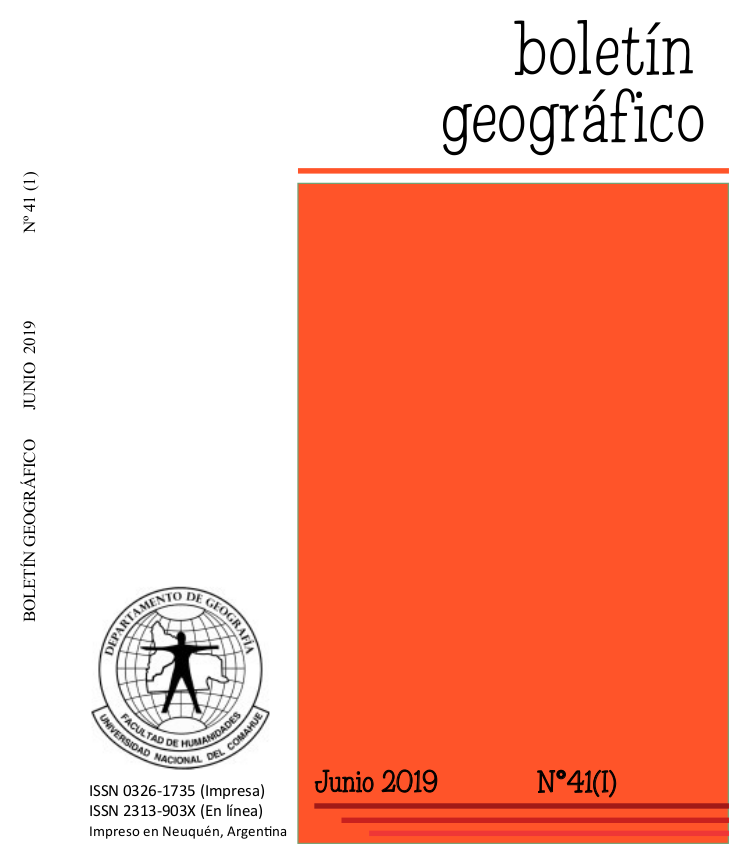Conceptualización del riesgo de desastre. Hacia la comprensión de su construcción
Palabras clave:
Riesgo, Desastre, Amenaza, Vulnerabilidad, ConstrucciónResumen
La revisión conceptual muestra como el concepto de riesgo ha ido adquiriendocomplejidad en su abordaje y construcción, a medida que también se complejiza la
situación ambiental de los asentamientos humanos. El presente artículo tiene como propósito realizar una revisión de los conceptos vinculados al riesgo de desastre - amenaza, vulnerabilidad, exposición y resiliencia- desde una perspectiva sociocultural. Esto permitirá comprender las interrelaciones existentes entre ellos en el proceso de construcción de situaciones de riesgo y, en etapas posteriores, comprender y explicar la construcción del riesgo en el ejido de Neuquén. En este contexto, es la variable histórica la que establece como se ha desarrollado la interacción entre el medio natural y la sociedad en una región, desencadenando así situaciones peligrosas para la población. Queda explícito en el desarrollo del trabajo que el riesgo es el resultado de una construcción social, en la cual, las condiciones físicas de la naturaleza son el desencadenante, pero el proceso de ocupación de los territorios propicia la existencia de escenarios de riesgo y desastres. Al estar presente la acción del hombre, el riesgo es producto del accionar de una sociedad que no reconoce y no respeta las leyes de la naturaleza. Neuquén es un ejemplo de ello. Ha crecido entre barrios planificados, viviendas particulares y asentamientos ilegales, muchos de los cuales han ocupado lugares naturalmente no adecuados para la urbanización. La ciudad es muestra de que el crecimiento urbano desordenado, la falta de obras de mitigación y el rol del Estado han llevado a la construcción de vulnerabilidades y a la generación de situaciones de riesgo ambiental que muchas veces terminan materializándose en un desastre con graves daños en viviendas, infraestructura de servicios, calles y personas evacuadas, como sucedió en la tormenta de abril del 2014, en la cual el 80 % de la planta urbana se vio inundada con consecuencias diferenciales en los distintos sectores del ejido.
Descargas
Citas
Acosta, V. G. (2005). El riesgo como construcción social y la construcción social de riesgos. Desacatos. Centro de Investigaciones y Estudios Superiores En Antropología Social, 11–24.
Blaikie, P., Cannon, T., Davis, I., & Wisner, B. (1996). Vulnerabilidad: El Entorno Social, Político y Económico de los Desastres.
Cardona, O. D., & Otros, Y. (2003). Banco interamericano de desarrollo.
Universidad Nacional de Colombia-Sede Manizales Instituto de Estudios
Ambientales-IDEA-Programa de información e indicadores de gestión de
riesgos Indicadores para la Gestión de Riesgos.
Jurio, E. M., Cappelletti, V., & Torrens, C. (2017). Construcción del riesgo ambiental en la cuenca superior del río aluminé-provincia del neuquén. Eje temático 7: procesos ambientales, complejidad y riesgos. In Dpto. de Geografía. Facultad de Humanidades. UNNE (Ed.), VI Congreso Nacional de Geografía de Universidades públicas y XVI Encuentro de Profesores en Geografía del Nordeste Argentino. Resistencia, Chaco.
Jurio, E. M., & Torrens, C. V. (2015). Lo que la lluvia nos dejó: impacto de las inundaciones en la ciudad de neuquén. In Seminario Internacional “Ciencias Sociales y Riesgo de Desastres en América Latina: Un encuentro inconcluso” (pp. 1–16). Buenos Aires: PIRNA-.
Narváez, L., Lavell, A., & Ortega, G. P. (2009). La gestión del riesgo de desastres: un enfoque basado en procesos. (Secretaría General de la Comunidad Andina, Ed.). Lima, Perú.
Publicado
Cómo citar
Número
Sección
Licencia
Derechos de autor 2019 Boletín GeográficoLa aceptación de colaboraciones por parte de la revista implica la cesión no exclusiva de los derechos patrimoniales de los autores a favor del editor, quien permite la reutilización bajo Licencia Atribución-NoComercial-SinDerivadas 2.5 Argentina (CC BY-NC-ND 2.5 AR)
Usted es libre de:
Compartir — copiar y redistribuir el material en cualquier medio o formato
La licenciante no puede revocar estas libertades en tanto usted siga los términos de la licencia
Bajo los siguientes términos:
Atribución — Usted debe dar crédito de manera adecuada, brindar un enlace a la licencia, e indicar si se han realizado cambios. Puede hacerlo en cualquier forma razonable, pero no de forma tal que sugiera que usted o su uso tienen el apoyo de la licenciante.
NoComercial — Usted no puede hacer uso del material con propósitos comerciales.
SinDerivadas — Si remezcla, transforma o crea a partir
El simple hecho de cambiar el formato nunca genera una obra derivada, no podrá distribuir el material modificado.
No hay restricciones adicionales — No puede aplicar términos legales ni medidas tecnológicas que restrinjan legalmente a otras a hacer cualquier uso permitido por la licencia.
La cesión de derechos no exclusivos implica también la autorización por parte de los autores para que el trabajo sea alojado en el repositorio institucional y difundido a través de las bases de datos que el editor considere apropiadas para su indización, con miras a incrementar la visibilidad de la revista y sus autores.
FORMULARIO DE CESIÓN DE DERECHOS DE AUTOR



















